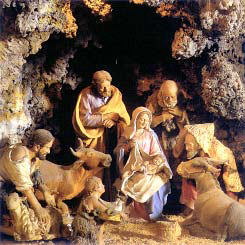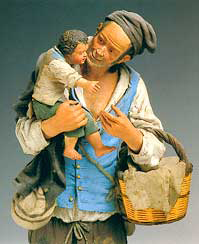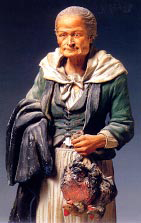Caltagirone was  founded as early as the 2nd century B.C. on a steep hill made of clay. The abundance and the good quality of the raw material encouraged the making of pottery and its trade.
founded as early as the 2nd century B.C. on a steep hill made of clay. The abundance and the good quality of the raw material encouraged the making of pottery and its trade.
First the Romans, then the Greeks, the Arabs, the Spanish and the Normans dominated the city, bringing in their traditional designs and techniques which merged into a unique ceramic production and one of the most distinctive Sicilian pottery traditions.
The Nativity figures were certainly part of the local production already during the Middle Age, as reported in many documents, although no actual example has ever been found due to the terrible earthquake that destroyed the city in 1693.
However, it can be argued that no proper artistic production took place before the 18th century. At this time the more talented potters started to make hand modeled freestanding figures that represented not only the key characters in the Nativity crib, but also the local characters in their daily tasks: the cheese maker, the hunter, the shepherd and so on.
The Real world became part of the Sacred world, carrying into the Nativity Scene the ever changing social scenario, the attitude of people, their everyday clothes and even their common gestures.
The Church, the most well-off families,  monasteries and religious orders ordered these little artworks and arranged beautiful Nativity scenes that they proudly and publicly showed in the weeks before Christmas. The noble palaces’ doors that were shut all year long suddenly opened to let anyone in, and people were encouraged to go around to see the scenes and to report about the most splendid ones.
monasteries and religious orders ordered these little artworks and arranged beautiful Nativity scenes that they proudly and publicly showed in the weeks before Christmas. The noble palaces’ doors that were shut all year long suddenly opened to let anyone in, and people were encouraged to go around to see the scenes and to report about the most splendid ones.
The Nativity figures makers were called “Santari” or “Pasturari” and the first ones who enjoyed public recognition for their artistry were Antonio Branciforti ed Antonio Margioglio.
At the end of the 18th century Giuseppe e Giacomo Bongiovanni dignified the art of making hand modeled and painted terracotta figures and encouraged the makings of their nephew, Bongiovanni Vaccaro, whose works are important additions to the British Museum of London and to many European collections.
After him, the fame of the Nativity scenes from Caltagirone was huge and no well-to-do family in Sicily could do without them.
The last representative of the Nativity Scene artists was Father Benedetto Papale, who designed and built the most was fascinating scenes of his century and, as “Santaro” himself, made some really fine figures.
 What is absolutely special in the clay figures from Caltagirone is their psychological and physical resemblance to the society and time in which they were conceived.
What is absolutely special in the clay figures from Caltagirone is their psychological and physical resemblance to the society and time in which they were conceived.
The chronicles written by the travelers to Sicily in the 18th century described the life of the lower and medium classes in exactly the same way of the theatrical mis-en-scene of Caltagirone Nativity scenes.
This is also where Caltagirone tradition differs from the more fanciful and over refined Nativity scenes from Naples and Palermo, which skip the simple facts of daily life to create an ideal and happy world.
The tradition of making Nativity scenes is still deeply rooted in Caltagirone and Christmas is the ideal time for a stunning visit to the place. Many scenes are permanent, others are created each year with figures from the past or the current production. Indeed, local potters do have a good hand and an inspired mind when making their unique terracotta figures, an important part of the heritage of Sicily.

Hi Yohannan,
we are not professionally prepared for appraisals, but we are delighted to have people sharing with us information on the Italian ceramics they own and love. Thanks!
Greetings, we have a figurative in terra cotta signed Guiseppe Vaccaro Caltagirone without any colour. He is a man in traditional clothing of the period who could be a soldier? But he has an amazing time weathered face and hands. I have photos to show. How much should he be insured for? What is the current replacement cost for the nephew Guiseppe Vaccaro?
Do you sell these? Molto grazie, Yohanan Walensis de S
I am looking for information on a clay sculpture of a man in native costume from early 19th century, signed G Vaccaro Caltagirone. It is not painted, but natural. Can some one please assist me?
Thank you so much, Gianni
Are this nativity scenes made in different size if so what sizes and dimensions on figurines please and prices